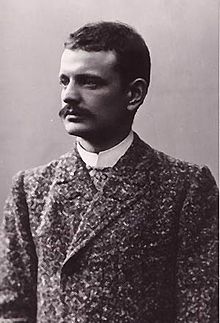
Jean Sibelius was a Finnish composer of the late Romantic and early-modern periods. He is widely regarded as his country's greatest composer, and his music is often credited with having helped Finland develop a stronger national identity when his country was struggling from several attempts at Russification in the late 19th century.
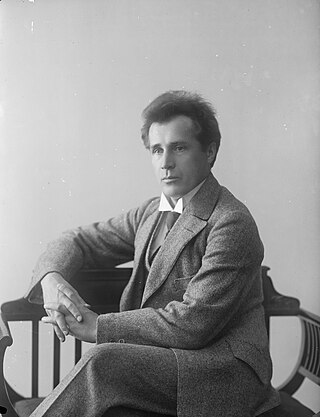
Leevi Antti Madetoja was a Finnish composer, music critic, conductor, and teacher of the late-Romantic and early-modern periods. He is widely recognized as one of the most significant Finnish contemporaries of Jean Sibelius, under whom he studied privately from 1908 to 1910.

Finlandia, Op. 26, is a tone poem by the Finnish composer Jean Sibelius. It was written in 1899 and revised in 1900. The piece was composed for the Press Celebrations of 1899, a covert protest against increasing censorship from the Russian Empire, and was the last of seven pieces performed as an accompaniment to a tableau depicting episodes from Finnish history. The premiere was on 2 July 1900 in Helsinki with the Helsinki Philharmonic Society conducted by Robert Kajanus. A typical performance takes between 7½ and 9 minutes depending on how it is performed.
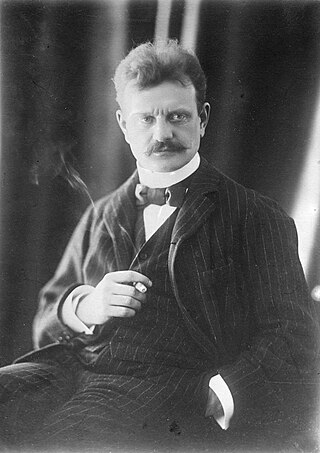
The Symphony No. 2 in D major, Op. 43, is a four-movement work for orchestra written from 1901 to 1902 by the Finnish composer Jean Sibelius.

Aulis Heikki Sallinen is a Finnish contemporary classical music composer. His music has been variously described as "remorselessly harsh", a "beautifully crafted amalgam of several 20th-century styles", and "neo-romantic". Sallinen studied at the Sibelius Academy, where his teachers included Joonas Kokkonen. He has had works commissioned by the Kronos Quartet, and has also written seven operas, eight symphonies, concertos for violin, cello, flute, horn, and English horn, as well as several chamber works. He won the Nordic Council Music Prize in 1978 for his opera Ratsumies.
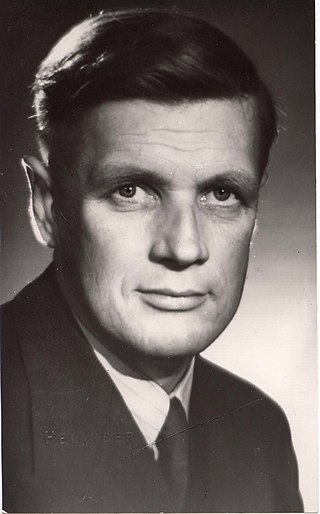
Uuno (Kalervo) Klami was a Finnish composer of the modern period. He is widely recognized as one of the most significant Finnish composers to emerge from the generation that followed Jean Sibelius.

Ernst Leopold Christian Mielck was a Finnish composer and pianist of the late Romantic period. A precocious but sickly youth, his promising career was cut short in its infancy when he died of consumption in Locarno, Switzerland, at age 21. As a result, Mielck's œuvre is small; his most acclaimed compositions are the Symphony in F minor and the Dramatic Overture.

Kullervo, Op. 7, is a five-movement symphonic work for soprano, baritone, male choir, and orchestra written from 1891–1892 by the Finnish composer Jean Sibelius. Movements I, II, and IV are instrumental, whereas III and V feature sung text from Runos XXXV–VI of the Kalevala, Finland's national epic. The piece tells the story of the tragic hero Kullervo, with each movement depicting an episode from his ill-fated life: first, an introduction that establishes the psychology of the titular character; second, a haunting "lullaby with variations" that portrays his unhappy childhood; third, a dramatic dialogue between soloists and chorus in which the hero unknowingly seduces his long-lost sister; fourth, a lively scherzo in which Kullervo seeks redemption on the battlefield; and fifth, a funereal choral finale in which he returns to the spot of his incestuous crime and, guilt-ridden, takes his life by falling on his sword.

Robert Kajanus was a Finnish conductor, composer, and teacher. In 1882, he founded the Helsinki Orchestral Society, Finland's first professional orchestra. As a conductor, he was also a notable champion and interpreter of the music of Jean Sibelius.

King Christian II, Op. 27, is incidental music by Jean Sibelius for the Scandinavian historical play of the same name, written by his friend Adolf Paul. The original play deals with the love of King Christian II, ruler of Denmark, Sweden and Norway, for a Dutch girl, Dyvecke, a commoner. Sibelius composed in 1898 seven movements. He conducted the first performance of the first four parts the Swedish Theatre in Helsinki on 24 February 1898. In the following summer, he composed three more movements, Nocturne, Serenade and Ballad. The Nocturne was an interlude between the first act and the second. The position of the serenade changed. The ballad is a dramatic piece about the Stockholm Bloodbath (1520). This movement shows already traits of the later First Symphony. The stage music consists of the following numbers:
- Elegia
- Musette
- Menuetto
- Sången om korsspindeln
- Nocturne
- Serenade
- Ballade.

Tapiola, Op. 112, is a tone poem by the Finnish composer Jean Sibelius, written in 1926 on a commission from Walter Damrosch for the New York Symphony Society. Tapiola portrays Tapio, the animating forest spirit mentioned throughout the Kalevala. It was premiered by Damrosch on 26 December 1926.
The Tempest (Stormen), Op. 109, is incidental music to Shakespeare's The Tempest, by Jean Sibelius. He composed it mainly in the late summer 1925, his last major work before his tone poem Tapiola. Sibelius derived two suites from the score.

The Maiden in the Tower, JS 101, is an opera in one act—comprising an overture and eight scenes—written in 1896 by the Finnish composer Jean Sibelius. The piece was a collaboration with the Finnish author Rafael Hertzberg, the Swedish-language libretto of whom tells a "simple tale of chivalry" that may nonetheless have had allegorical ambitions: the Bailiff abducts and imprisons the Maiden ; although she endures hardship, she remains true to herself and is freed subsequently by her Lover and the Chatelaine of the castle.

Belshazzar's Feast, JS 48, is incidental music by Jean Sibelius to a play of the same name by the journalist, poet and playwright Hjalmar Fredrik Eugen Procopé (1868−1927).

The Symphony No. 1 in F major, Op. 29, is a three-movement orchestral composition by the Finnish composer Leevi Madetoja, who wrote the piece from 1914–16 at the dawn of his professional career. Although late-Romantic in style, the symphony carefully eschews the extravagance and overindulgence typical of debut efforts, placing it among the most "mature" and restrained of first symphonies. Accordingly, the First is the shortest and most concentrated of Madetoja's three essays in the form and is the only one of his symphonies not to adhere to the traditional four-movement symphonic template.

The Symphony No. 2 in E-flat major, Op. 35, is a four-movement orchestral composition by the Finnish composer Leevi Madetoja, who wrote the piece from 1916–18 immediately following the success of his First Symphony (1916). Composed during the Finnish Civil War, the Second stands as "the most significant musical document" of the conflict and finds its composer, "deeply scarred by the experience", reflecting upon national tragedy and personal loss. Accordingly, Madetoja's Second is the longest and most dramatic of his three essays in the form and, perhaps for this reason, is the most popular of the set.
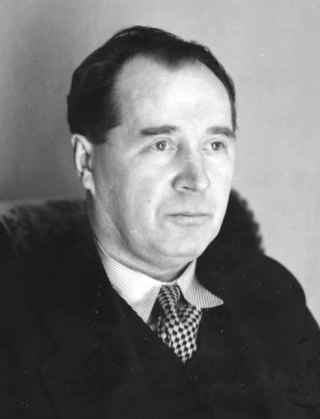
Juha, Op. 74, is a verismo opera in three acts—comprising six tableaux—written from 1931 to 1934 by the Finnish composer Leevi Madetoja. The libretto, a collaboration between Madetoja and the Finnish soprano Aino Ackté, is based on Juhani Aho's 1911 novel by the same name. The story takes place on the border between West Karelia and East Karelia, and features as its central conflict a love triangle between the farmer Juha, his young wife Marja, and a Karelian merchant, Shemeikka. Disillusioned with rural life and seduced by promises of material comfort and romance, Marja runs away with Shemeikka; Juha, who maintains his wife has been abducted, eventually discovers her betrayal and commits suicide by jumping into the rapids.

The Symphony in F minor, Op. 4, is a four-movement symphony for orchestra written from 1896 to 1897 by the precocious, 19-year old Finnish composer Ernst Mielck. The piece, reportedly inspired by Hans Christian Andersen's fairy tale "The Ice-Maiden", premiered in Helsinki on 20 October 1897, with Robert Kajanus conducting the Helsinki Orchestral Society. The next year, on 3 December, Mielck experienced the greatest moment of his career when the Berlin Philharmonic, one of the world's most acclaimed orchestras, played his symphony. This success, however, was short-lived, as Mielck died of consumption on 22 October 1899 while on medical leave in Locarno, Switzerland. As such, the F minor Symphony is his only contribution to the symphonic canon.

Kullervo, Op. 15, is a symphonic poem for orchestra written in 1913 by Finnish composer Leevi Madetoja. The piece premiered on 14 October 1913 with Madetoja conducting the Helsinki Philharmonic Society.
